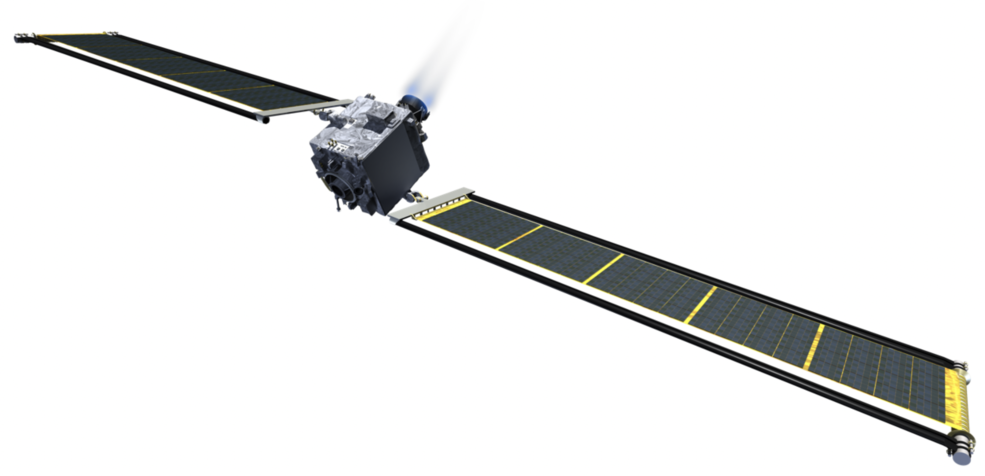I've never noticed this before, but the two solar arrays of NASA and APL's DART spacecraft are at different "levels". In this image, the solar panel on the left extends out from the "top" face of the craft, while the solar panel on the right extends out the "bottom" face.
 This setup seems quite different from depictions of solar panels in other spacecraft, like Dawn, where the solar panels seem to be at the same level, and the spars connecting the panels are always depicted as horizontal with respect to the "top" and "bottom" faces. Why was DART designed with this rotational symmetry, but not reflection symmetry? Am I misunderstanding something about the design?
This setup seems quite different from depictions of solar panels in other spacecraft, like Dawn, where the solar panels seem to be at the same level, and the spars connecting the panels are always depicted as horizontal with respect to the "top" and "bottom" faces. Why was DART designed with this rotational symmetry, but not reflection symmetry? Am I misunderstanding something about the design?
-
2$\begingroup$ Maybe could have something to do with how much space they take up with rolled all the way in? This is also the first use of ROSA (roll-out solar array) in deep space. $\endgroup$– DuckCommented May 29, 2021 at 7:35
-
$\begingroup$ @Duck Interesting! I've just asked Where all is ROSA (roll-out solar array) planned to be used? $\endgroup$– uhohCommented May 30, 2021 at 6:20
-
1$\begingroup$ Does this answer your question? Offset of the DART roll out solar arrays $\endgroup$– FredCommented Jan 31, 2022 at 9:48
-
1$\begingroup$ @Fred this indeed seems to be the same question, but the two answers on that one start with "this is just a guess" and "I don't know for sure" $\endgroup$– SpeedphoenixCommented Jan 31, 2022 at 10:10
-
2$\begingroup$ I've voted for the other question to be closed as duplicate of this, but perhaps in this case the two questions can be merged and all three answers can appear together, so voting to leave open for that reason. $\endgroup$– uhohCommented Jan 31, 2022 at 11:16
1 Answer
DART uses the Roll-Out Solar Arrays (ROSA) and is one of the first spacecraft to do so - certainly the first interplanetary one. ROSA has been demonstrated on the ISS and is going to become a primary power generator for it soon. But ROSA is still fairly new technology, and space engineering is generally technologically conservative.
DART is a fairly small spacecraft as you can see from the images below. The first is a diagram showing DART in its stowed launch configuration. The ROSAs are rolled up, and the resulting cylinder is parallel to the spacecraft's longitudinal axis. In the photo, you can see that next to the rolled-up ROSA is a rectangular-ish white panel which forms the yoke connecting the ROSA proper to the gimbal. The gimbal will rotate the array about an axis perpendicular to the spacecraft longitudinal axis. There is a deployment hinge between the yoke and the gimbal. Once in flight, the hinge is released and swings open, then the ROSA is commanded to unroll. And you end up with the deployed configuration as shown in the original question.
Note that the gimbal is on the edge of the spacecraft, not in the center of the face. That's why the deployed configuration looks odd. Most spacecraft put the gimbal in the center of the panel rather than on the edge (for mass balance and other reasons). In this case, however, you would need to add another hinge and deployment mechanism to get everything to fold properly - simply because there isn't room on this small spacecraft to avoid it. That means more weight and cost, but most important of all, it's another thing that could fail. And in this case, it could jeopardize your ability to generate enough power, and the entire mission would be a failure. So keep it simple, and that's what APL did.
https://www.nasa.gov/sites/default/files/thumbnails/image/pd-dart-spacecraft-bus.png